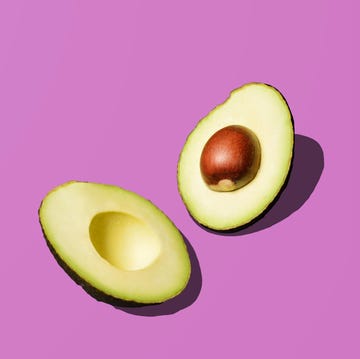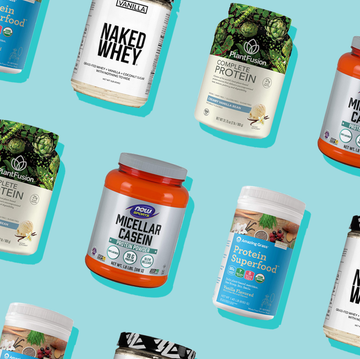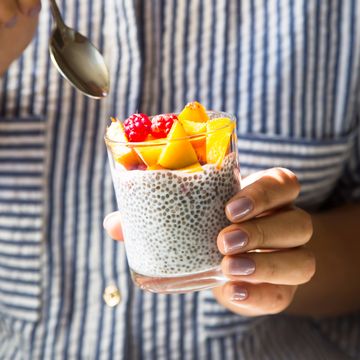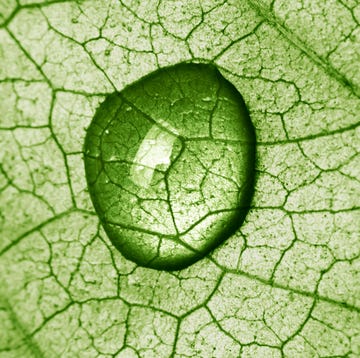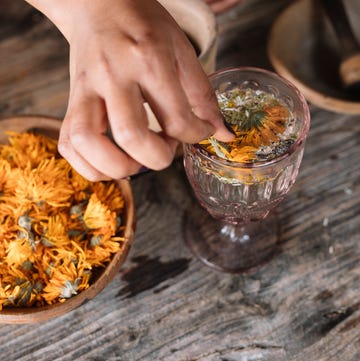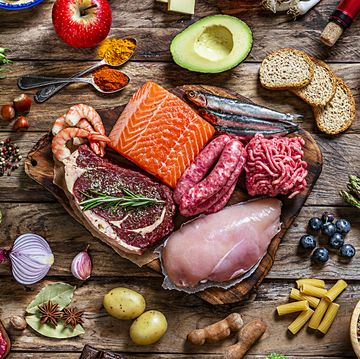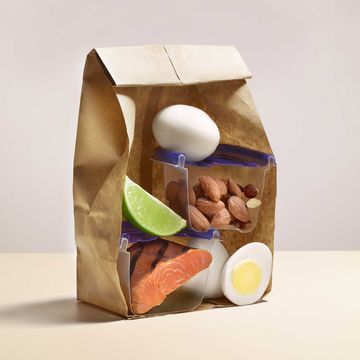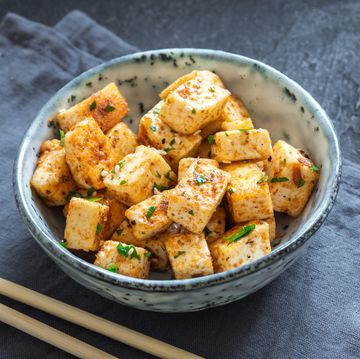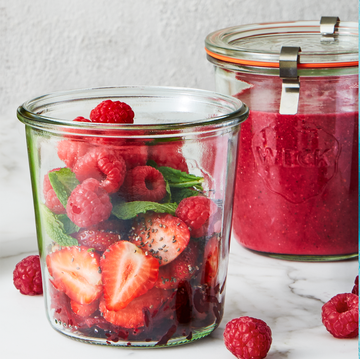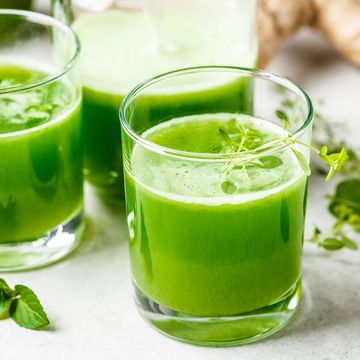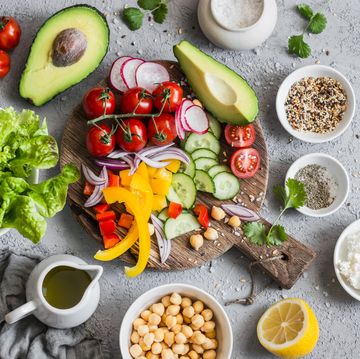You don't need a PhD in biochemistry to know that food is fuel and that it affects our energy levels. But you have to be smart if you're eating for energy. "Certain eating strategies will definitely help you ward off fatigue," says Stacey Whittle, RD, a registered dietitian at the University of Southern California in Los Angeles.
Ironically, the very food we so often rely on for quick energy—concentrated sources of sugar, like candy bars or soda—are the very foods that you should avoid if you want enduring energy, say experts.
Here's why: Your body uses food for energy by turning it into blood sugar, or glucose. Carbohydrates convert most easily into this ready-to-burn fuel, making them your macronutrient of choice for energy eating. The problem is that some simple carbohydrates, like sugar, tend to break down so fast that, after providing a short-lived burst of energy, they leave your blood sugar levels low, your energy inadequate, and your plans for the day unaccomplished. Complex carbohydrates, like grains, replace this spike-and-dip act with a steady energy supply that keeps you going at full throttle.
Striking The Optimal Energy Balance
You don't have to radically change your diet to include nothing but high energy foods to ratchet up your energy levels. Chances are, you're already eating many of the foods best suited for daylong energy. It's simply a matter of eating them at the right time, in the right amounts, and in the right combinations.
What's the ideal mix? High (but not exclusively) carbohydrates, moderate protein, low (but not no) fat. Think of a turkey sandwich with low-fat mayo, a small serving of spaghetti and meatballs, or a bowl of chili.
Distribute your calories equally among breakfast, lunch, and dinner. A skimpy breakfast, a hurried lunch, and a huge evening feast is about the least energy-efficient eating schedule imaginable. "What do you need all those calories for if you're going to bed?" says Debra Wein, RD, cofounder of Sensible Nutrition Connection in Hingham, Massachusetts.
"Anybody who's ever done justice to a Thanksgiving dinner knows that you get tired when you overstuff," says Ann Grandjean, EdD, director of the International Center for Sports Nutrition in Omaha, Nebraska.
Never, ever skip a meal. "Many women skip breakfast," Wein says. "And some may even skip lunch because they think it will help them lose weight." But by skipping breakfast or lunch—or both—not only are you depriving your body of calories just when it needs them the most, you're also likely to compensate with a lethargy-inducing pig-out when you do eat. So much for weight loss! "And if you keep skipping meals, the result over time is a general malaise," Wein says.
Eat five meals a day. The experts favor adding a midmorning and midafternoon snack to your daily meal schedule, and downgrading your other three meals accordingly to keep your total calories where you want them. This mini-meal plan is a super energy booster because you're getting energy into your body right when you need it, you won't be going too long between meals, and you're less likely to overeat or undereat. "If you watch your portion size and take time for that midmorning and midafternoon snack, you'll be surprised at how positively your energy levels are affected," Whittle says.
Wein suggests the following energizing calorie allotments: If you're a fairly typical weight-watching woman, your calorie count per day will probably fall between 1,400 and 2,000. If you're at the higher number, shoot for 500 calories at breakfast, lunch, and dinner, with midmorning and midafternoon snacks at 250. If you're down at 1,400 total calories, your meals should be 400 calories each, with two 100-calorie snacks.
*Julia VanTine and Debra L. Gordon are authors of Maximum Food Power for Women, the book from which this article is excerpted.[pagebreak]
If you're overweight, slim down. "Carrying around 10 or 20 pounds of excess weight in the form of body fat is like dragging an anchor," says Wayne Askew, PhD, professor of nutrition and director of the division of foods and nutrition at the University of Utah in Salt Lake City. "The best way to feel energetic is to maintain a proper body weight for your height and frame size."
Forget crash-dieting. It's pretty hard not to get enough calories in our food-privileged country, but lots of women go out of their way to do just that. Low-calorie diets—fewer than 1,200 calories a day, depending on your size—can sap your energy. For one thing, it's more challenging to get the nutrients you need once you go below 1,800 calories a day. And, though every woman has different calorie needs, consuming fewer than 10 calories per pound of body weight is clearly too low, Grandjean says. "The body compensates by going into a lower gear."
The Power Duo
Vitamins and minerals don't provide energy directly, but they're big-time players in processing energy. So if you don't get enough of them, you may find yourself waking up tired and staying that way. Lots of variety in fruits and vegetables is the best way to get the whole array of micronutrients, from vitamin A to zinc. But for energy, try these two strategies:
- Drink lots of fresh orange juice. Believe it or not, perhaps one out of three women isn't getting enough vitamin C, says Carol Johnston, PhD, assistant professor of food and nutrition in the family resources department at Arizona State University in Tempe. Vitamin C helps produce carnitine, a molecule that helps your body burn fat for energy. "People likely have up to a 50% drop in muscle carnitine levels when they're vitamin C-depleted," she says. Johnston thinks 200 to 300 mg daily is enough for you to feel more energy, assuming that you were short on C. You can get that much without supplementing if you drink orange juice (one 8-ounce glass a day) and eat a diet high in vitamin C-rich foods, including kiwifruit (70 mg per fruit), raw red or green bell pepper (142 mg and 60 mg per 1/2 cup, respectively), broccoli (51 mg per 1/2 cup cooked), strawberries (49 mg per 1/2 cup), and brussels sprouts (48 mg per 1/2 cup cooked).
- Be sure to get enough iron. Iron is a must mineral for energy because of its role in transporting oxygen via red blood cells to wherever it's needed in the body. Too little iron creates a cascade of problems that end up lowering your metabolic rate—and your energy levels. A lot of women aren't getting the 18 mg a day of iron they need in their diets. A half-cup of soybeans contains 9 mg of iron; a half-cup of baked beans, 8 mg; a half-cup of spinach, 6 mg; 3 oz. of beef, 5 mg; and 3 oz of fried oysters, 6 mg. If you think you're anemic or have significantly low iron levels, see your primary-care physician before taking iron supplements.
More from Prevention: The Best Supplements For Women[pagebreak]
Power Breakfasts
"When you wake up in the morning, you've gone 6 to 8 hours without taking in any calories," Wein points out. "That is the time to wake up your body by providing it with the right kind of calories to burn for energy."
So if you skimp on breakfast, you run the risk of a lackluster morning, since your blood sugar will probably be low and stay low, depriving your brain of the glucose it needs. Here's how to eat a true power breakfast:
- Hold the pancake syrup. Sweet breakfasts are an energy disaster, since nothing plummets your blood sugar faster (after an initial boost) than concentrated forms of simple carbohydrates like corn or maple syrup. Pouring one of them over refined carbohydrates like white flour pancakes or waffles exaggerates the effect. Whittle warns that any sweet topping with corn syrup in it—like the typical maple-flavored syrup or a lot of jellies—is an especially good bet to spike-and-dip your blood sugar to lethargic levels. So try some healthier and more energizing alternatives, she suggests. Go for French toast made with whole grain bread and egg substitute, or use a whole grain flour like buckwheat in your pancake or waffle mix. Top them off with your favorite fruit instead of syrup.
- Reach for some protein. While fruit and whole grain cereal are fine morning choices, your breakfast carbohydrates still need to be balanced with some protein foods for more enduring energy, Whittle says. The fat-free milk or low-fat yogurt you add to the cereal will work. Or go for eggs or egg substitutes with an English muffin or a slice of whole grain toast.
- Shoot for 3 g of fiber per serving. Whole grains, unlike refined flour products, deliver energy laced with fiber, which slows down the digestion so that the energy is released over a longer period of time. That's why whole grain, high-fiber cereals are an excellent breakfast selection for all-morning energy. "Look for one with at least 3 g of fiber per serving," Wein says. "Some have 8 g or more. Eat it with fat-free milk, and you have a perfect balance."
- Stock up on oatmeal. A fiber-packed whole grain cereal, oatmeal is your best breakfast choice for long-lasting energy, says William Evans, PhD, director of the nutrition, metabolism, and exercise laboratory at the University of Arkansas for Medical Sciences/Veterans Affairs Medical Center in Little Rock. Evans credits oatmeal's energy-boosting ability with its soluble fiber content. Much more than the insoluble fiber in, say, wheat bran, the soluble fiber in oatmeal slows down carbohydrate absorption, thus keeping your blood sugar levels more constant. Both oat bran and rolled oats are high in soluble fiber, so on mornings when you don't feel like eating oatmeal, try oat bran muffins.
Ace Midmorning Meetings
Faced with an interminable meeting, it's all too easy to rely on the doughnut-Danish-bagel axis: low-fiber, protein-free, high-refined-carb foods that yo-yo your glucose levels. Instead, reach for steady-energy allies. Here are some suggestions from the experts:
- A peanut butter sandwich Make it with whole wheat bread, and it will have the macronutrient mix that will keep your eyes open and your brain humming. That's because the fiber in the whole wheat and the protein (and fat) in the peanut butter will ration out the energy over time. "Even if you'd like to add a little jelly, it's going to be absorbed slowly because of the peanuts, which have fat and fiber, so your blood sugar won't plummet," says Whittle. Another good option is peanut butter on apple slices. An apple is almost pure carbohydrate, with simple sugars, but the energy it provides will be metered over time by its own fiber and by the peanut butter.
- Fruit and cheese Chop up half an apple (for carbohydrates) and mix it with 1% cottage cheese (for its protein and some fat), and bring it to work for balanced midmorning fortification, suggests Whittle. Equally healthy variations are low-fat cheese on whole grain bread or a small salad with tuna and chopped apples.[pagebreak]Vim In The Afternoon
Lunch should leave you invigorated, not asleep at your workstation. Make these adjustments to come back strong for the day's second act:
- Take it easy. Hefty lunches of 1,000 calories or more are proven energy sappers. "Portion size is key," says Whittle. "Most people overeat at lunch."
- Pass on pure pasta. Unless you're planning to run a marathon after lunch, it's probably not a good idea to overemphasize pasta or any other refined carbohydrate at lunchtime. "Susceptibility to grogginess after a high-carbohydrate lunch is more common in women than men, and in people over 40," Grandjean says. Better carb choices are fiber-rich whole grain bread, brown rice, and beans or lentils instead of white bread, white rice, or white pasta.
- Push the protein. Along with choosing fiber-rich unrefined complex carbohydrates, the next best thing you can do to ramp up your afternoon energy levels is to offset your lunch carbohydrates with a high-protein food, Whittle says. Excellent midday protein choices are soy burgers, seafood, tuna, turkey, or cottage cheese.
- Build a high-energy salad. "Just a salad" is a common lunch request by weight-watching women, but a plateful of not much more than lettuce hardly qualifies as energy food even for rabbits. "A typical lunch should be 400 to 500 calories, so salads usually just aren't enough," Wein says. Instead, she suggests making your own lunch salads with energy in mind. "Choose dark leafy greens, which are higher in nutrients and fiber," she says. "Add a variety of colorful vegetables such as carrots, peppers, and broccoli. And always include a low-fat source of protein such as chickpeas or grilled chicken to round it out."[pagebreak]
Power Up For Lunchtime Workouts
If you're going to be exercising at lunchtime, make your midmorning snack higher in carbohydrates than you otherwise would. If you exercise after work, up the carbohydrate content of your midafternoon snack. "Those carbohydrates an hour or so before exercising will serve directly as energy to burn for your workout," Wein says. It is also a great way to provide energy to your muscles during your workout, she adds.
You could have a half-cup of raisins (115 g carb), a half-cup of tropical trail mix (92 g), 10 pretzels (48 g) or an 8 oz cup of low fat yogurt (43 g).
And eat your next meal soon after you finish your workout. Exercise itself lowers blood sugar, so enjoying a balanced meal afterward will help stabilize glucose levels and keep you going for the rest of the day. (Need some lunchtime workout ideas? Check out Noontime Burn And Firm.)
Beat Afternoon Slump
As any woman knows, the workday doesn't end when you leave the office. After-hours errands, or what have you, put extended demands on your stamina. A midafternoon snack can help see you through. Plus, you won't get home so hungry that you inhale the first thing that you get your hands on, or overeat at dinner.
The ideal midafternoon snack consists of the same mix of components as a good breakfast or midmorning snack: a mini-meal that includes protein and some fat as well as carbohydrates—say, the other half of a turkey sandwich, or a couple more peanut butter crackers.
Eat To Beat The Heat
If you notice that you tire more easily in the summer, heat itself isn't necessarily to blame. "Dehydration is what makes you tired," Grandjean says. That's because your body will keep its cells hydrated at all costs, she says, so if you don't replace water lost through perspiration, it will simply take water out of the circulating blood, reducing your blood volume. "As your blood volume goes down, your heart has to work a little harder," she says. "Your body adapts to that by slowing down, and that affects your general feeling of vitality." So your daily 8 or 9 glasses of water become more important on hot days, and, in fact, may not be enough on some days.
Discover new ways to shed pounds and heal yourself naturally. Order your copy of Joy Bauer's Food Cures today!
More from Prevention: 11 Fast Fixes For Instant Energy



